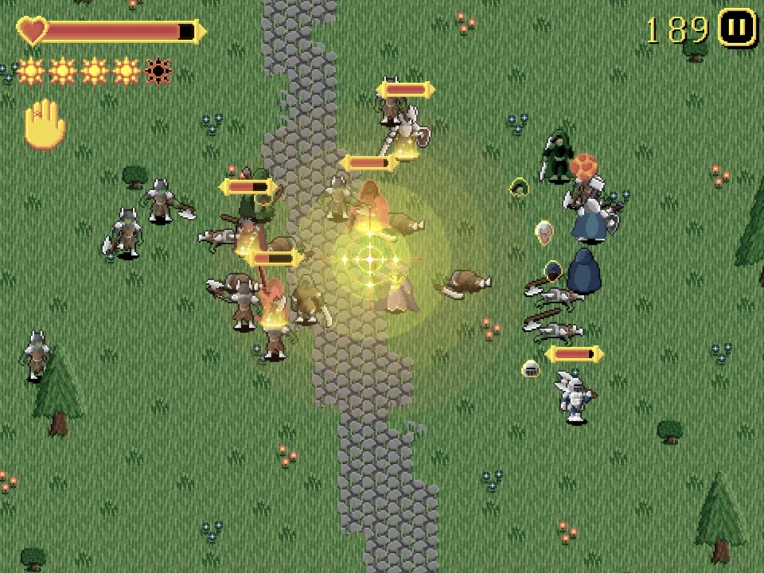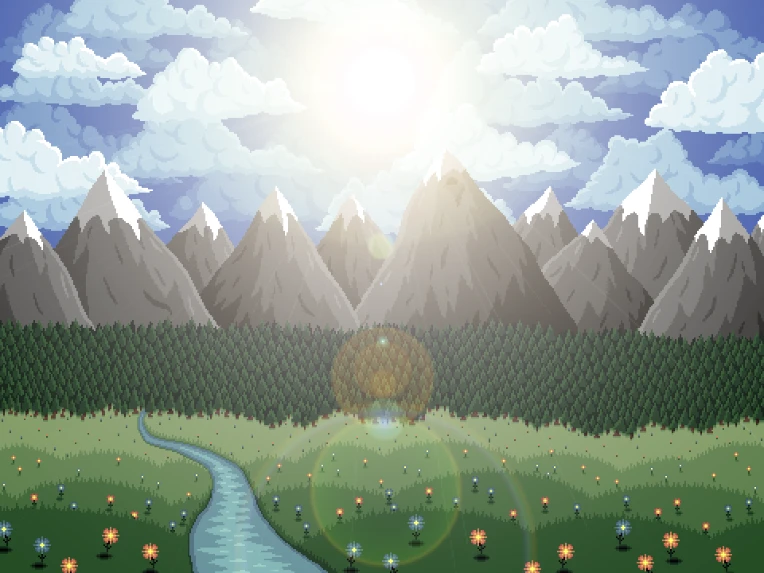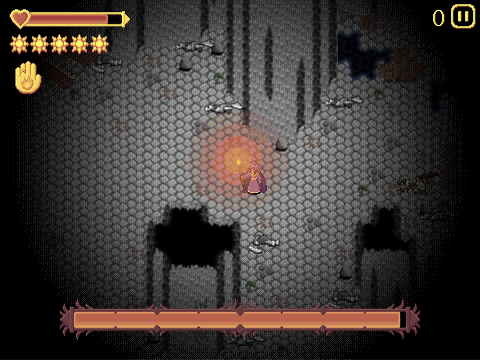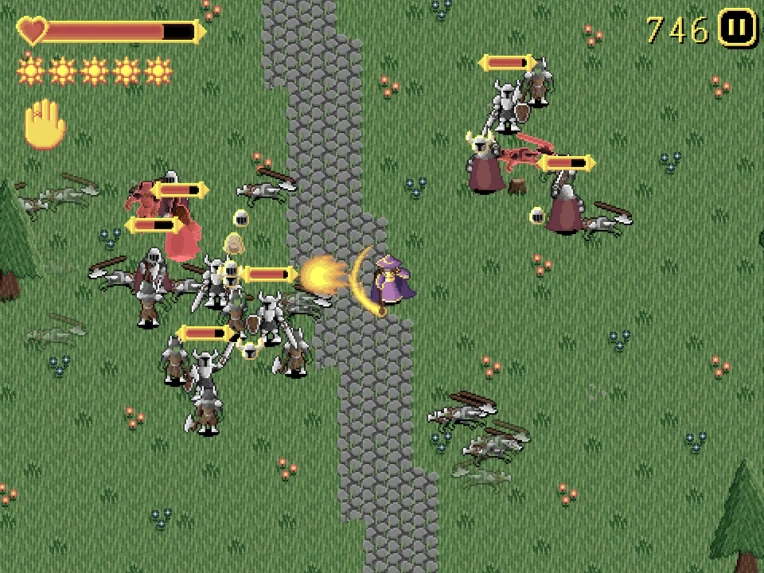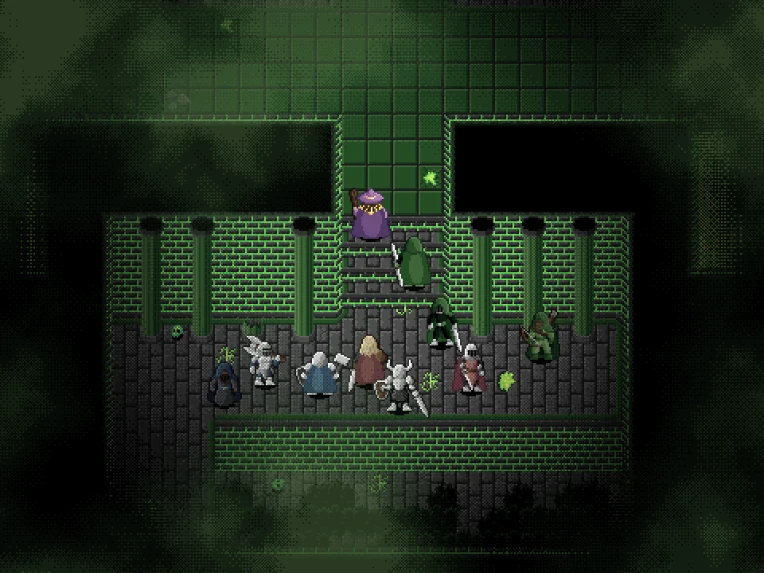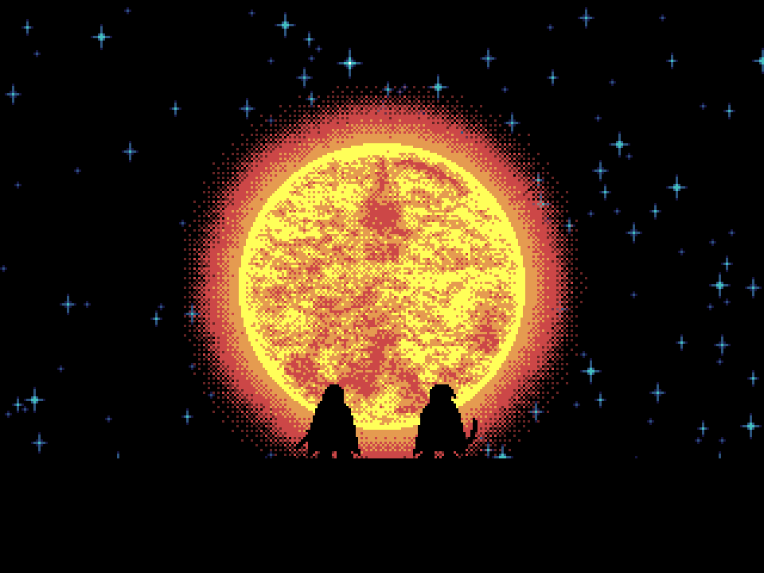This guide aims to provide a detailed explanation of every game mechanic in The Legend of Quintavius. If you have any questions, difficulties, or curiosities, then this is for you.
You don’t have to know any of this to play the game. It’s designed so you can just jump in and figure everything out as you go. All you need to know are the basics: move around, heal allies, and attack monsters. This is simply for anyone who wants to know more.
Since this is a chunky post, here’s a table of contents for your convenience.
- Basic stats
- Character AI
- Morale: Difficulty curve
- Difficulty scaling
- Quintavius’ stats and abilities
- The magic ring
- Soldiers’ and Monsters’ stats and abilities
- Boss’ stats and abilities
- Where to find the lost pages
Another thing I’ll make clear is the terminology I use for describing characters, so it’s not confusing who I’m talking about. The first is of course “character,” which just refers to any and all persons in the game. “Soldier” and “ally” refers to anyone in your party fighting alongside you. “Enemy” refers to anyone who fights against you and your party, and “monster” refers to most standard enemies, while “boss” refers to more powerful and unique enemies. “Target” refers to whoever a specified character is attacking.
Greul is a little different because he isn’t a boss, but he has boss-like qualities. You could say that he’s more of a miniboss. He’s basically just a very strong monster.
“Player” can refer to either Quintavius or you yourself, the person playing the game. Sometimes the two terms can be used interchangeably, but other times the distinction matters. It just depends on the context.
Basic stats
All characters start at max health, which is of course the most health they can have. All damage always reduces the health of all characters by 1. This means a character’s max health is a measure of how many times they can take damage.
After taking damage, most characters are immune to damage for a brief moment (0.2 seconds). Quintavius has an additional 0.4 seconds of invincibility frames after that, unless you’re in hardmode (see Difficulty scaling). Theroth has no i-frames.
Characters can move in 4 directions, up, down, left, and right. In Stencyl, 1 unit of speed is equal to 10 pixels per second, so a character’s movement speed in pixels per second is 10x their listed value.
Attack speed is the time it takes for a character to attack. When a character attacks, they play an animation, and at some point during that animation, damage is dealt or a projectile is fired. The time it takes to do that after the animation begins is what I call a “windup.” Then after that, there’s some amount of time before the character can attack again.
For example, Quintavius has an attack speed of 0.7, with 0.3 windup. This means that when he attacks it takes 0.3 seconds for him to fire, and 0.4 seconds after that before he can attack again.
A character with 0 windup instantly deals damage or fires their projectile.
Most characters actually have one of only two attack speeds, either a slower 1.6 seconds with 0.4 windup, or a faster 0.8 seconds with 0 windup. So because of that, and also for simplicity and ease of understanding, I’m listing the attack speed of characters below as “fast” or “slow” next to their exact value. You don’t have to know the exact value, you just see that a character in particular is a fast attacker or a slow attacker in general.
Character AI
Soldiers and monsters, your allies and most enemies, have an AI that controls their actions in battles. The first thing they do is look for a target character to pursue, usually one closest to them. Then they move towards their target, navigating around obstacles and other characters in the way. Then once they reach their target, they begin attacking until the target is defeated or some other interruption happens.
Most characters are melee attackers, dealing damage if their target is close enough to them.
- Strategies: Most melee enemies have a windup time before they deal damage, so you can allow them to collide with you and begin their attack animation, then move away from them at just the right moment, effectively dodging the attack.
Other characters can attack their targets by firing a projectile, preferring to keep their distance to avoid taking damage themselves. Projectiles have a set speed and can pierce a certain number of targets before they disappear, and in most cases they follow the same 4-way movement. So ranged attackers have to line themselves up with their target on either the X or Y axis before firing.
As you can imagine with 20 or so characters all fighting each other at once, things get complicated, and characters need to be able to adapt to the situation. Most characters will attack a target they weren’t already pursuing if they just happen to bump into them. If a monster targets or bumps into a ranged soldier and damages them, the soldier will move away instead of continuing to attack their target. And soldiers won’t look for a monster if there aren’t any, or if they need healing, and instead they’ll try to return to Quintavius.
Notice how I say things like “try” and “usually.” Because as you can imagine with 20 or so characters all fighting each other at once, things get complicated.
There’s also some characters with special/unique abilities that bend or even break these rules, so those will be described with them.
Morale: Difficulty curve
Because this game clearly isn’t complicated enough, and because I wanted it to be even more interesting and dynamic, I wanted to try my hand at adjusting the difficulty of battles dynamically.
The first way I did this was by increasing the difficulty curve with a stat called “Morale.” It makes soldiers weaker and monsters stronger the closer the party gets to the dungeon. Morale is +1 in the town, 0 in the fields, -1 in the forest, -2 in the mountains, and -3 in the dungeon, where a positive value boosts soldiers and a negative value boosts monsters. Quintavius and bosses are not affected by Morale.
The way each character is affected depends on whether they’re classified as either “fast” with a high movement speed or “tough” with high max health, because usually a fast character is not as tough, and a tough character is not as fast. Any character with 10 or more movement speed is considered fast, and any character with less than 10 speed is considered tough.
The idea is that the weaknesses of soldiers are worsened, while the strengths of monsters are enhanced. So tough soldiers will get slower and lose speed, fast soldiers will get weaker and lose health, tough monsters will get tougher and gain health, and fast monsters will get faster and gain speed. Speed is adjusted by Morale flatly, and health is adjusted by 1.5x Morale, rounded up or down (that’s +2 health for 1 Morale, +3 health for 2 Morale, and +5 health for 3 Morale).
Interestingly, since Morale is a positive value in the town, it has the opposite effect and improves the soldiers’ weaknesses while lessening the monsters’ strengths. In the fields, everyone’s stats remain their base value. I also list the values of characters’ stats in the dungeon, where Morale is most extreme, next to their base stats.
Difficulty scaling
The second way difficulty is adjusted is to make the game easier if the player is struggling, to try and figure out what they’re struggling with and adjust that accordingly. It’s different from the difficulty curve, which is applied after winning battles to increase difficulty. In some cases, difficulty scaling can cancel out the difficulty curve.
Difficulty scaling is applied every time Quintavius is defeated and the player receives a game over.
First, every ally that was defeated before Quintavius gains +1 max health, up to a maximum of +5. The game assumes they struggled to survive, so it makes them a little stronger.
If the party was fighting a boss, or if Greul was present, their max health is reduced. For Greul it’s -1 to a minimum of -10 (65 max health), for the gnome it’s -1 to a minimum of -5 (30 max health), for the dragon it’s -2 to a minimum of -20 (30 max health), and for Theroth it's -5 to a minimum of -50 (200 max health). This makes boss battles less difficult the more you lose to them.
During regular battles, if more than a third of the total army of monsters was defeated, that total count is reduced by 5. If more than two thirds of the army was defeated, it’s reduced by 10. The total number of monsters can’t fall below 60. The game assumes that you aren’t really struggling, so it just shortens the time it takes to win the next attempt. This doesn’t apply to the gnome battle, where the army is endless.
Otherwise, if you lost the battle quickly, the game determines if either Quintavius was too weak or the monsters were too strong. If any other allies were also defeated, the max health of all monsters is reduced by 1, to a minimum of -5. If Quintavius was the only defeated party member, then he gets +0.1 seconds of invincibility frames, up to a maximum of +0.6 seconds (a full 1 second in total).
Note that this also doesn’t apply to the gnome battle. Skeletons won’t lose max health because they already have only 5, and Quintavius won’t gain more i-frames.
By typing “hardmode” on the title screen, you can start the game without difficulty scaling if you don’t want it enabled. It also removes your extra invincibility frames, so you have 0.2 seconds like all other characters.
Quintavius’ stats and abilities
Ranged attacker
- Max health: 20
- Movement speed: 10 / 100 pps
- Attack speed: Fast (0.7 seconds, 0.3 windup)
- Damage over time: Attacks deal additional damage every second after the initial hit, up to 5 times (this means a counter tracks how long a character has had this “debuff,” and if they are hit by this attack again, it resets back to 5).
Fireballs
- Projectile speed: 50 / 500 pps
- Piercing: 5 or 1 (see magic ring)
- Doesn’t collide with tiles (except during dragon boss battle)
Quintavius also has the unique ability to heal allies, which the player controls by holding down the heal key. While healing, all allies within 100 pixels of Quintavius have their health increased every 0.4 seconds, and Quintavius’ mana is reduced by 1. He has 10 mana in total, and at 0 mana, he cannot heal allies.
The amount healed is divided among the allies, so the more allies you’re healing, the less each ally is healed individually. The exact equation is “heal amount = (ally’s max health / 8) / number of allies healed,” and this amount is rounded to a whole number. Additionally, if an ally is “in danger,” meaning they have 3/8 or less of their max health (just under half health), they’re healed by 1 more health point. Lastly, the final amount healed can’t be less than 1.
- Strategies: If you’re trying to heal an ally in danger while your other allies are fine, you can try to position yourself away from them, so the one in danger gets all the mana.
While the heal key is not held down, mana recharges by 1 every 0.4 seconds in the fields, every 0.6 seconds in the forest, every 0.7 seconds in the mountains, not at all in the caves, and every 1.2 seconds in the dungeon. The rate is determined by the amount of sunlight in the environment.
See Theroth’s stats and abilities below for the additional abilities Quintavius gains during the final boss battle.
The magic ring
The magic ring is my way of adding optional playstyles to the game. It has a different effect depending on which hand Quintavius wears it on.
By default it’s on his left hand, which allows his fireballs to pierce up to 5 enemies before dissipating. This is an active playstyle for people who want to juggle the responsibilities of both healing allies and helping them fight monsters.
But on the right hand, Quintavius’ fireballs lose their piercing very shortly after they’re fired. Instead, Quintavius has healing over time: +1 health every 10 seconds in the fields, 12 seconds in the forest, 13 seconds in the mountains, 20 seconds in the caves, and 15 seconds in the dungeon. This is more casual, for anyone who wants to focus more on healing and dodging monsters, making battles slower but slightly easier.
- Strategies: You can still hit multiple enemies by firing right next to them, so the fireballs hit them before they lose piercing.
It’s meant for you to choose which hand to wear the ring on at some point early in the game, depending on how you want to play, and you can change your mind any time.
- Strategies: If you can juggle another task, you can swap the ring from one hand to the other mid-battle as needed.
Soldiers’ and Monsters’ stats and abilities
Fredrickson
Tough / Melee attacker
- Max health: 45
- Movement speed: 9 / 90 pps (10 in town, 6 in dungeon)
- Attack speed: Slow (1.6 seconds, 0.4 windup)
- Takes attention: This character forces the character they damage to target them instead of whoever they might’ve been targeting instead (a “taunt” ability).
Vanguard
Tough / Melee attacker
- Max health: 35
- Movement speed: 8 / 80 pps (9 in town, 5 in dungeon)
- Attack speed: Slow (1.6 seconds, 0.4 windup)
- Shield: Characters with a shield can block melee attacks, as long as they’re facing the attacker and aren’t also attacking themselves. They will also delay their next attack to block an incoming attack.
- Takes attention
Swordsman
Fast / Melee attacker
- Max health: 25 (27 in town, 20 in dungeon)
- Movement speed: 10 / 100 pps
- Attack speed: Fast (0.8 seconds, 0 windup)
Dmitri
Tough / Melee attacker
- Max health: 40
- Movement speed: 8 / 80 pps (5 in dungeon)
- Attack speed: Slow (1.6 seconds, 0.4 windup)
- Shield
- Takes attention
Paladin
Tough / Melee attacker
- Max health: 35
- Movement speed: 9 / 90 pps (6 in dungeon)
- Attack speed: Slow (1.6 seconds, 0.4 windup)
Mystic
Tough / Ranged attacker
- Max health: 30
- Movement speed: 9 / 90 pps (6 in dungeon)
- Attack speed: Slow (1.6, 0.4 windup)
Magma spheres
- Projectile speed: 15 / 150 pps
- Piercing: 3
- Collides with tiles
Nevariel
Fast / Melee/ranged attacker (see below)
- Max health: 30 (25 in dungeon)
- Movement speed: 11 / 110 pps
- Attack speed: Fast (0.8, 0 windup)
- High evasion: This character dodges all attacks while they’re moving.
Double bladed sword
- Projectile speed: 50 / 500 pps
- Piercing: infinite
- Doesn’t collide with tiles
Nevariel has a unique ability to throw her weapon, every 5 to 10 seconds or so, as long as she isn’t already attacking an enemy at melee distance. Her weapon pierces all enemies and slows down before returning to her like a boomerang.
Assassin
Fast / Melee attacker
- Max health: 20 (15 in dungeon)
- Movement speed: 11 / 110 pps
- Attack speed: Fast (0.8 seconds, 0 windup)
- High evasion
Archer
Fast / Ranged attacker
- Max health: 25 (20 in dungeon)
- Movement speed: 11 / 110 pps
- Attack speed: Fast (0.8 seconds, 0 windup)
- High evasion
Arrows
- Projectile speed: 50 / 500 pps
- Piercing: 1
- Doesn’t collide with tiles
Goblin
Fast / Melee attacker
- Max health: 15
- Movement speed: 10 / 100 pps (9 in town, 13 in dungeon)
- Attack speed: Slow (1.6 seconds, 0.4 windup)
Orc
Tough / Melee attacker
- Max health: 20 (25 in dungeon)
- Movement speed: 9 / 90 pps
- Attack speed: Slow (1.6 seconds, 0.4 windup)
Troll
Tough / Melee attacker
- Max health: 50 (52 in forest, 55 in dungeon)
- Movement speed: 5 / 50 pps
- Attack speed: Very slow (2.0 seconds, 0.4 windup)
- Knockback: This character will shove aside any other characters in their way while they pursue their target. When they damage their target, they’ll also push them back a little.
Greul
Tough & Fast / Melee/ranged attacker (see below)
- Max health: 75 (85 in dungeon)
- Movement speed: 12 / 120 pps (13 in dungeon)
- Attack speed: Slow (1.6 seconds, 0.4 windup)
- Takes attention
- Knockback
Axe
- Projectile speed: 50 / 500 pps
- Piercing: infinite
- Collides with tiles
Greul’s Morale gives him a flat boost to both health and speed in the dungeon. In the mountains, his stats are the base value.
Greul will also throw his weapon every few seconds, similar to Nevariel. However, after he throws it, it slows down and falls to the ground, and he has to retrieve it. He cannot attack without it.
Greul is notorious for waiting to enter battle until his opponents have been weakened by his minions. In the mountains, he only joins partway through, and in the dungeon he flees when he’s about to be defeated, returning a little while later with 20 health recovered.
Boss’ stats and abilities
Gnome
Ranged attacker
- Max health: 35
- Movement speed: 12 / 120 pps
- Attack speed: Slow (1.6 seconds, 0.4 windup)
- Cannot be set on fire
Magic orbs
- Projectile speed: 15 / 150 pps
- Piercing: 5
- Doesn’t collide with tiles
Being the only enemy who is a true ranged attacker with no melee attacks, the gnome will try to avoid you and your allies. To keep his distance, he’ll try to run circles around the battlefield.
- Strategies: The easiest and fastest way to defeat him is to get your allies to surround him and prevent him from escaping.
Every few seconds, he will stop and perform a ritual to summon skeletons to fight for him, if there aren't already enough skeletons in combat. Skeletons attack quickly and are very difficult to dodge, but they’re also very weak.
- Strategies: Setting a skeleton on fire just once will ensure their defeat, because Quintavius’ fire deals damage over time 5 times, and skeletons only have 5 health.
Skeleton
Melee attacker
- Max health: 5
- Movement speed: 10 / 100 pps
- Attack speed: Fast (0.8 seconds, 0 windup)
Dragon
Ranged attacker
- Max health: 50
- Movement speed: 0
- Attack speed: Very slow (7 ±3 seconds)
- Cannot be set on fire
- Damage over time
Magma vomit
- Projectile speed: 40 / 400 pps
- Piercing: infinite
- Collides with tiles, until enraged (see below)
The dragon doesn’t move and deals contact damage, preventing you from moving past her. Instead she periodically leans forwards and spews several projectiles at you. The average time between each attack is 7 seconds, but this can vary by up to 3 seconds. She might take 10 seconds to attack, and then attack again 4 seconds later.
She has 2 projectiles that she spits in a few different patterns. One is a ball of magma that falls to the ground and explodes with a small area of effect, and the other is a fireball that flies straight and sets you on fire, dealing damage to you once every second for 5 seconds (the same as Quintavius’ DoT).
However, there is also water in the scene, which douses you and stops the damage over time early whenever you step into it.
Her attacks will collide with tiles, allowing you to hide behind them, until her theme loops back to the start for the second time. Then she will become enraged, indicated by a roar, after which her projectiles no longer collide with tiles.
Unlike all other enemies, the dragon is defeated when she falls to 1/8th of her max health.
Theroth
Melee/ranged attacker (see below)
- Max health: 250
- Movement speed: 7 / 70 pps
- Attack speed: see below
- Cannot be set on fire
Strange matter
- Projectile speed: random
- Piercing: infinite
- Doesn’t collide with tiles
Theroth doesn’t stop moving when he collides with you, instead trampling you and dealing contact damage.
Theroth follows an attack pattern, where every few seconds he performs a unique ability.
- First, if Quintavius is within striking distance, he winds up for 0.6 seconds and then swings his extendable chain sword, dealing damage up to about 200 pixels away from him in a straight line. If enough time passes without Quintavius ever being within this striking distance, Theroth moves on to the next attack in his attack pattern.
- Next he stops and sprays projectiles in a wide area in front of him for a few seconds, which fall to the floor and splat, remaining there for 10 seconds. In phase 1, these projectiles instantly defeat Quintavius.
- Then he will attack with his chain sword again. If Quintavius never gets close enough, Theroth moves to his next attack.
- Next he stomps the floor, causing a few holes to appear around the arena, creating small obstacles that Theroth is tall enough to walk over but Quintavius needs to move around.
- After that, he spews projectiles again. Then he returns to the start of his attack pattern.
In phase 1, Quintavius can charge a spell while he isn’t moving, which grants him a duration of i-frames at the start of phase 2 equal to the time he spent casting the spell in phase 1. Theroth will end phase 1 after his theme finishes playing, performing a cinematic drain ability that has no effect on gameplay. This triggers a cutscene that leads to phase 2.
In phase 2, Quintavius gains his i-frames and additional new abilities. Theroth’s projectiles no longer instantly defeat him, and his heal ability, which now recharges every 0.4 seconds again, now cleanses Theroth’s projectiles. Quintavius also throws 4 fireballs in quick succession whenever he attacks, and they also destroy Theroth’s projectiles. Theroth doesn’t have i-frames so that every fireball will damage him.
Where to find all lost pages
There are 13 in total. I won’t point out their exact location directly, but I will tell you what scenes or areas they’re in so you know where to look. And look carefully; some of them are very well hidden.
The first page is in the cutscene that plays before the title screen. If you missed it the first time, you can wait on the title screen until the song ends, or type “cutscene.”
6 pages are in each of the areas you explore; the fields, forest, mountains, caves, stronghold, and dungeon.
There’s a page in the town hall, at the old wizard’s tower, and where you fight Theroth. And there’s a page in each of the 3 ending scenes (and you have to be quick with that last one).
If you’re still stuck, here are some more hints.
After you’ve found them all… what do you do with them? What do these symbols mean? Maybe it’s written down somewhere else . . .
I hope this guide was helpful or insightful. Like I said, ultimately the gameplay is about people running around and hitting each other with pointy sticks. The fact that there’s so much going on that you should only keep track of the information you need, is really the whole point. So take from this what you will, and I hope you have fun playing.
